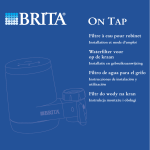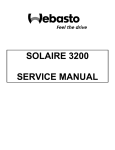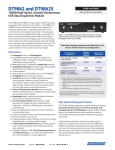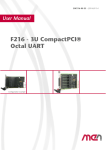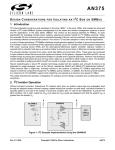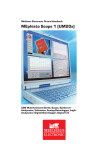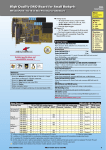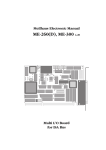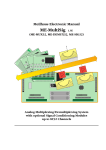Download ME-5810 - Meilhaus Electronic
Transcript
Meilhaus Electronic Manual
ME-5810 1.5E
Opto-isolated Digital-I/O Board
with Bit-pattern Detection, 3 x 16 bit Counters (8254)
(alternative configuration: Frequency Measurement and Pulse Generator)
Imprint
ME-5810 Manual
Version 1.5E
Issued on: 17. Oktober 2013
Meilhaus Electronic GmbH
Fischerstraße 2
D-82178 Puchheim/Munich
Germany
http://www.meilhaus.com
© Copyright 2013 Meilhaus Electronic GmbH
All rights reserved. No part of this publication may be reproduced or distributed in any
form whether photocopied, printed, put on microfilm or be stored in any electronic media
without the expressed written consent of Meilhaus Electronic GmbH.
Important note:
The information contained in this manual has been reviewed with great care and is believed
to be complete and accurate. Meilhaus Electronic assumes no responsibility for its use, any
infringements of patents or other rights of third parties which may result from use of this
manual or the product. Meilhaus Electronic assumes no responsibility for any problems or
damage which may result from errors or omissions. Specifications and instructions are
subject to change without notice.
Borland Delphi is a trademark of Borland International Inc.
Turbo/Borland C is a trademark of Borland International Inc.
Visual C++ and Visual Basic are trademarks of the Microsoft Corporation.
VEE Pro and VEE OneLab are trademarks of Agilent Technologies.
ME-VEC and ME-FoXX are trademarks of Meilhaus Electronic.
Other company names and product names found in the text of this manual are also
trademarks of the companies involved.
Manual ME-5810
Rev. 1.5E
Table of Contents
1
2
3
Introduction...................................................................................................... 5
1.1 Important Notes ..................................................................................... 5
1.1.1 Intended Use ................................................................................ 5
1.1.2 Improper Use................................................................................ 6
1.1.3 Unforeseeable Misuse.................................................................... 6
1.2
1.3
Scope of Supply....................................................................................... 7
Features .................................................................................................. 8
1.4
1.5
System Requirements............................................................................ 12
Software Support .................................................................................. 12
Initial Operation ............................................................................................. 13
2.1
2.2
Software Installation ............................................................................. 13
Test Program ........................................................................................ 13
2.3
2.4
Fitting the Plug-on Boards .................................................................... 14
Power Supply for PCI-Express Models.................................................. 15
Hardware ........................................................................................................ 17
3.1 Block Diagram ...................................................................................... 17
3.2
3.3
ME-5810 cPCI .................................................................................... 18
ME-5810 PCIe .................................................................................... 18
3.4
3.5
ME-5002 ............................................................................................. 19
Digital Input/Output ........................................................................... 20
3.5.1 Opto-isolated Inputs
........................................................... 20
3.5.2 Opto-isolated Outputs
.......................................................... 21
3.5.2.1 Sink Driver ................................................................. 21
3.5.2.2 Source Driver.............................................................. 23
3.5.3 External Trigger ........................................................................ 25
3.5.3.1 External Trigger Inputs ............................................... 25
3.5.3.2 Edge Detection ........................................................... 25
3.6
3.7
Frequency Input/Output
................................................................ 25
Counters ............................................................................................... 26
3.7.1 Wiring of the Counters .......................................................... 27
3.7.2 Pulse width modulation .............................................................. 28
Meilhaus Electronic
Seite 3
Table of Contents
Rev. 1.5E
3.8
4
Manual ME-5810
External Interrupt ..............................................................................29
Programming ..................................................................................................31
4.1 Single Operation Mode .........................................................................34
4.1.1 Digital Input/Output
..........................................................34
4.1.2 Frequency Input/Output ........................................................35
4.1.2.1 Frequency Measurement ........................................36
4.1.2.2 Pulse Generator .......................................................37
4.1.3 Counters (8254) .......................................................................38
4.1.3.1 Standard Operation Modes .........................................38
4.1.3.2 Pulse Width Modulation ............................................39
4.2
4.3
Streaming Operation Mode...................................................................40
4.2.1 Digital Input/Output
......................................................40
4.2.1.1 Stream Timer ..............................................................40
4.2.1.2 Stream Trigger Sample ................................................40
4.2.1.3 Wraparound Mode .................................................. 40
4.2.1.4 External Trigger ..........................................................41
Interrupt Operation .........................................................................42
4.3.1 Bit-pattern Change ...................................................................42
4.3.2 Bit-pattern Compare ..............................................................44
Appendix ...............................................................................................................45
A
Specifications ........................................................................................45
B
C
D
E
Pinout ..................................................................................................52
B1
78-pin D-Sub (ST1) – ME-5810..................................................53
Accessories ............................................................................................54
Technical Questions..............................................................................55
D1
Hotline.........................................................................................55
D2
Service address..............................................................................55
D3
Driver Update ..............................................................................55
Index.....................................................................................................57
Table of Contents
Seite 4
Meilhaus Electronic
Manual ME-5810
1
Rev. 1.5E
Introduction
Valued customer,
Thank you for purchasing this device from Meilhaus Electronic. You have chosen an innovative high technology product that left our premises
in a fully functional and new condition.
Take the time to carefully examine the contents of the package for any
loss or damage that may have occurred during shipping. If there are any
items missing or if an item is damaged, contact us immediately.
Before you install the board in your computer, we recommend to read
this manual carefully, especially the chapter describing board installation.
The descriptions in this manual apply equally to the PCI-Express and
the CompactPCI versions of the ME-5810 series, except where differences are explicitly mentioned.
1.1
Important Notes
1.1.1
Intended Use
The plug-in PC boards of the ME-5000 series are used to acquire and
output both analog and digital signals using a PC. The models of the
ME-5000 series are for fitting:
•
… in a free PCI Express slot (PCIe) or
•
… in a free CompactPCI slot (cPCI),
according to the type. Please first read the instructions for use of your PC
for the procedure to follow when fitting a plug-in board.
Observe the following notes and specifications starting on page 45:
•
Make sure that heat can be dissipated from the board well enough inside the PC housing.
•
Unused inputs must always be connected to the reference ground of
their subdevice, in order to avoid crosstalk between the input
channels.
•
The partially opto-isolated inputs and outputs provide electrical isolation of the device of up to 1000 V with respect to the PC ground.
Meilhaus Electronic
Seite 5
Introduction
Rev. 1.5E
1.1.2
Manual ME-5810
•
Note that the computer must be switched on first before any voltage
is applied to the board through external circuitry.
•
Connecting or disconnecting any of the the board's plug-in connectors must always be done when all the components are powered
down.
•
Make sure that when touching the board, or when plugging in the
connecting cable, it is not possible for static discharges to pass
through the board.
•
Ensure that the connecting cable is securely seated. The plug must be
fully inserted into the D-sub socket, and secured using both screws.
Only in this way can the board be expected to function properly.
Improper Use
Plug-in PC boards for the PCI Express or CompactPCI bus must never
be operated outside the PC. Never connect the devices to electrically live
parts, and particularly not to any that carry mains voltage.
Make sure that the external circuitry connected to the device cannot
come into contact with electrically live parts. Connecting or disconnecting any of the the plug-in connectors must always be done when powered down.
1.1.3
Unforeseeable Misuse
The device is not suitable for use as a child's toy, for domestic purposes
or under adverse ambient conditions (such as in the open air). The user
must take appropriate precautions to avoid unforeseeable misuse.
Introduction
Seite 6
Meilhaus Electronic
Manual ME-5810
1.2
Rev. 1.5E
Scope of Supply
We do, of course, endeavour to supply you a complete product package.
Nevertheless, to make entirely sure that your supply is complete, you can
check the contents of your package with the help of the following list.
Your package should contain the following parts:
•
Opto-isolated digital-I/O boards for the PCI Express or CompactPCI bus of type ME-5810A or ME-5810B (incl. ME-5002)
•
Manual in PDF format on CD/DVD
(optionally available in printed form)
•
Driver software on CD/DVD
•
78-pin D-sub mating connector
Meilhaus Electronic
Seite 7
Introduction
Rev. 1.5E
1.3
Manual ME-5810
Features
The ME-5810 series PC boards are opto-isolated digital-I/O boards with
bit-pattern detection and counters for PCI-Express and CompactPCI
systems. In this user manual “ME-5810” is used for all versions of the
cards, whereas “ME-5810A” or “ME-5810B” is used to describe special
features of these versions.
If required, certain subdevices can alternatively be configured for frequency measurement or for pulse generation (see chapter 4 from
page 31). As an option, the base-board can be extended with add-on
boards (see table 2 on page 11).
Model overview:
Model
Opto-DIO
Opto-FIO*
Counter
ME-5810A
1 x 16 bit DI
1 x 16 bit DO
4 FI channels
4 FO channels
3 x 16 bit
ME-5810A/S
1 x 16 bit DI
1 x 16 bit DO
4 FI channels
4 FO channels
3 x 16 bit
2 x 16 bit DI
2 x 16 bit DO
4 + 8 FI channels
4 + 8 FO channels
3 x 16 bit
2 x 16 bit DI
2 x 16 bit DO
4 + 8 FI channels
4 + 8 FO channels
3 x 16 bit
...with streaming operation
ME-5810B**
(ME-5810A + ME-5002)
ME-5810B/S**
(ME-5810A/S with streaming
operation + ME-5002)
Table 1: Model overview ME-5810 series
* Alternative configuration can be selected with ME-iDC.
** ME-5810A(/S) is always registered in the Windows device manager.
Introduction
•
Opto-isolated digital-inputs: The ME-5810 has 16 opto-isolated inputs. Further 16 opto-isolated inputs can be added using the plug-on
board ME-5002. The inputs run with a voltage high-level of 24 V
typ. (specifications see page 46).
•
Opto-isolated digital-outputs: Die ME-5810 has 16 opto-isolated
outputs. Further 16 opto-isolated outputs can be added using the
plug-on board ME-5002. The source-driver can drive up to 370 mA
per pin (all 16 outputs active). The detailed specifications of the sink
and/or source drivers can be found on page 46.
Seite 8
Meilhaus Electronic
Manual ME-5810
Rev. 1.5E
The source drivers are short-circuit-proof and are equipped with a
current limiting per channel. If required, the output driver can send
an interrupt on overload to the PC.
A suitable external source is required to supply the output drivers.
•
Frequency measurement: With the concept of “configurable subdevices” the subdevice 0 can also be used as a frequency counter. Four
independent channels are available to measure the frequency and
duty cycle of periodic rectangular signals (max. 5.5 MHz). 8 further
channels can be added using the plug-on board ME-5002.
•
Pulse generator: With the concept of “configurable subdevices” the
subdevice 1 can also be used as a rectangular signal generator. Four
independent channels are available to output a periodic rectangular
signal up to 5.5 MHz with selectable duty cycle. 8 further channels
can be added using the plug-on board ME-5002.
•
Sink/source selection: You can switch the output ports over from
sink to source drivers or high impedance by software for an optimal
adaption in industrial applications. “High impedance” means that
the voltage level at the output pin depends on your external application.
•
Bit-pattern detection: If required, the bit-pattern at the digital input
port can be monitored. Depending on the mode an interrupt can be
generated, if the bit-pattern changes or is equal/not equal to a given
bit-pattern. In streaming mode bit-pattern detection can be used to
control the input/output operation depending on the selected operating mode (no interrupt operation).
•
The isolation voltage between the opto-isolated inputs/outputs and
PC-ground is 1 kVACRMS.
•
The opto-isolated digital inputs of the ME-5810 and ME-5002 are
equipped with an overvoltage protection diode that can discharge
voltage pulses to ground for a short period of time.
Due to the DMA architecture data can be transmitted quickly between
PC memory and the board. In streaming mode an I/O-rate of 300 kHz
can be achieved, shared among all ports (see table 4). The actual transmission rate depends on the operating mode and on the configuration of
your PC.
Meilhaus Electronic
Seite 9
Introduction
Rev. 1.5E
Manual ME-5810
Depending on your application you can select between these operating
modes:
•
Single: In this mode a single value can be read or written under software control (see chapter 4.1.1 on page 34).
•
Streaming (“S” versions only): In this mode data I/O makes use of
the FIFO, either under timer control and/or controlled by external
trigger signals. Various trigger options are available that can be
defined as start and stop conditions. Subdevice 0 is defined as a 16 bit
input port and subdevice 1 as a 16 bit output port (see chapter 4.2.1
on page 40).
•
Interrupt: Used for interrupt processing in bit-pattern change and
bit-pattern compare mode (see chapter 4.3 on page 42).
Custom specific firmware versions are available on request.
Introduction
Seite 10
Meilhaus Electronic
Manual ME-5810
Rev. 1.5E
Model
ME-5810
ME-5001
ME-5002
ME-5004
PC interface
cPCI/PCIe
–
–
–
Board type
Base board
Plug-on board
Plug-on board
Plug-on board
DIO channels
1 x 16 bit DI,
1 x 16 bit DO
2 x 8 bit DIO
+ 4 x 8 bit DIO**
1 x 16 bit DI
1 x 16 bit DO
1 x 16 bit DI
1 x 16 bit DO
Streaming channels*
1 x 16 bit DI,
1 x 16 bit DO
–
–
I/O rate DI/DO
30MS/s / 30MS/s
–
–
Frequency FI/FO
300kHz/3kHz
5.5MHz/5.5MHz
300kHz/3kHz
300kHz/3kHz
Ext. trigger for
streaming
4*
–
–
–
Software start/stop
for streaming
4*
–
–
–
Frequency measurement
4 channels
8 channels
8 channels
8 channels
Pulse generator
4 channels
8 channels
8 channels
8 channels
Counter (8254)
3 x 16 bit
–
–
–
Bit-pattern change
4
4
4
4
Bit-pattern compare
4
–
4
4
12…30V
3.3V/5V
(4 x 8 bit***)
12…30V
12…30V
15…30V
3.3V/5V
(4 x 8 bit***)
15…30V
15…30V
Active termination
–
4 x 8 bit***
–
–
Opto-isolation
4
–
4
4
Sink/Source selection
4
–
4
4
Temp. monitoring
source driver
–
source driver
source driver
Field wiring
78pin D-Sub
female socket
25pin Sub-D
female socket
via 78pin D-Sub
of base board
37pin D-Sub
female socket
Configurable firmware
4
4
4
4
Configurable subdevices
4
4
4
4
DI/FI level
DO/FO level
Table 2: ME-5810 and plug-on boards in overview
*Streaming mode only for „S“ versions **opt. via ME-AK-D25F/S(cPCI) ***only for subdevice 0..3
Meilhaus Electronic
Seite 11
Introduction
Rev. 1.5E
1.4
Manual ME-5810
System Requirements
The ME-5000 series requires a PC with an Intel® Pentium® processor, or
compatible computer, with a free PCI Express or CompactPCI slot (see
also the specifications on page 45). The board is supported by the
Meilhaus Intelligent Driver System (ME-iDS) from Windows 2000
upwards (Linux under development).
1.5
Software Support
The ME-5000 series is supported by the Meilhaus Intelligent Driver System (ME-iDS). The ME-iDS is an unified driver system usable across
devices and operating systems. It supports Windows 8/7/Vista/XP/2000
(Linux under development) and contains a universal function library
(API) for programming.
You will find a detailed description of the functions in the ME-iDS manual, a copy of which is on the CD/DVD supplied.
Please also observe the notes in the appropriate README files.
Introduction
Seite 12
Meilhaus Electronic
Manual ME-5810
2
Rev. 1.5E
Initial Operation
Please read your computer manual instructions on how to install new
hardware components before installing the board.
2.1
Software Installation
• Installation under Windows
The following basic procedure should be used:
If you have received the driver software as an archive file please un-pack
the software before installing the board. First choose a directory on your
computer (e. g. C:\Temp\Meilhaus\ME-iDS).
Use the Meilhaus Intelligent Driver System (ME-iDS) for programming
your new data acquisition hardware. For installation and operation of the
driver system please follow the documentation in electronic form included with the software package.
• Installation under Linux
Note the installation instructions included with archive file of the appropriate driver.
Linux under development!
2.2
Test Program
•
ME-PowerLab3: Run the program from the Windows Start menu.
This will allow you to test all the important functions of the hardware.
•
You will find simple test programs in the SDK of the ME-iDS, in the
"Test Executables32" or "Test Executables64" subfolders.
Meilhaus Electronic
Seite 13
Initial Operation
Rev. 1.5E
2.3
Manual ME-5810
Fitting the Plug-on Boards
The boards should be handled with care in order to make sure that the
device is not damaged by electrostatic discharge (ESD), mechanical stress
or unsuitable current surges. Precautions should also be taken to avoid an
electric shock. Ensure that standard ESD safty precautions are taken. At
least one hand should be grounded in order to dissipate any static charge.
Observe the following procedure:
1. If the base board is installed, you must first remove it in order to be
able to insert the plug-on board. Here you should observe the
procedure as described in the manual for your PC system.
2. Make sure that electrostatic discharges cannot take place through the
plug-on board or the base board as you plug it in. Follow the
standard ESD safty precautions.
3. Push the plug-on board carefully, and with only a little force, on to
the male connector provided for it (see diagram 1, items 1, 2 and 3).
Check that the board is fully plugged in.
4. Choose two adjacent slots for the installation. If necessary, remove
an additional blanking plate for the slot of the plug-on board.
5. Carefully plug the combination of the base and plug-on board into
the computer.
6. Screw the two slot brackets down firmly.
7. Close the PC system again.
Diagram 1: Fitting the plug-on boards
Initial Operation
Seite 14
Meilhaus Electronic
Manual ME-5810
2.4
Rev. 1.5E
Power Supply for PCI-Express Models
Because of the PCI-Express slot drives not sufficient current for operation of the board, an additional supply is required via the PC power supply. For that purpose connect a free „MOLEX“ connector of the PC (also
as used for power supply of drives) with the appropriate terminal of the
board (see the following diagram). Else the board can be irreverseable
damaged!
MOLEX
+5V (PC)
PC_GND
PC_GND
n.c.
ST1
Diagram 2: Additional power to the PCI Express models
Meilhaus Electronic
Seite 15
Initial Operation
Rev. 1.5E
Initial Operation
Manual ME-5810
Seite 16
Meilhaus Electronic
Manual ME-5810
Rev. 1.5E
3
Hardware
3.1
Block Diagram
ME-5810
ME-5810(/S)
Subdevice 0 (ME-5810)
FIFO*
DI (single/streaming)
„IN“
DI_A0..15
FI (freq. measurement)
Iconst
Bit-pattern change
DO_B
0..15
Bit-pattern compare
Source driver
Temperature monitoring
Subdevice 1 (ME-5810)
Current limitation
DO (streaming)
78-pin D-sub female
Sink driver
FIFO*
„OUT“
FO (impulse generat.)
Sink/source
selection
Interrupt logic
IRQ
CLK_0…2
OUT_0…2
3x 16 bit counter (8254)
GATE_0…2
(subdevice (2..4))
ME-5002
ME-5810
Subdevice 0 (ME-5002)
(opt. add-on module)
DI (single)
DI_C0..15
FI (freq. measurement)
Iconst
Bit-pattern change
DO_D
0..15
Bit-pattern compare
Source driver
Temperature monitoring
Subdevice 1 (ME-5002)
Current limitation
DO (single)
Sink driver
FO (impulse generat.)
Sink/source
selection
Local address/data bus
PC interface
(cPCI: 33 MHz/32 bit or PCIe x1
Diagram 3: Block diagram of ME-5810
*Note: „FIFO IN“ and FIFO OUT“ for streaming mode are only
available on „S“ versions.
Pinout diagram of the 78-pin D-sub female connector in the appendix
(see „Pinout” on page 52).
Meilhaus Electronic
Seite 17
Hardware
Rev. 1.5E
Manual ME-5810
In the following chapters you will learn more about the external wiring
of the functional sections. Chapter 4 from page 31 describes the operation modes and the programming.
3.2
ME-5810 cPCI
ME-5810 cPCI
REV.: 1.1
ST1
Diagram 4: ME-5810 cPCI
ME-5810 PCIe
ME-5810 PCIe
REV.: 2.0
MOLEX
3.3
ST1
Diagram 5: ME-5810 PCIe
Hardware
Seite 18
Meilhaus Electronic
Manual ME-5810
3.4
Rev. 1.5E
ME-5002
ME-5002
REV.: 1.2
Diagram 6: ME-5002
Meilhaus Electronic
Seite 19
Hardware
Rev. 1.5E
3.5
Manual ME-5810
Digital Input/Output
The ME-5810 series opto-isolated ports have been designed for applications in industrial control applications (typ. 24 V). An external power
supply (pin: VCC_EXT) is required for the opto-isolated digital outputs.
Depending on the application, the drivers of the output ports can be
configured as sink or source or high impedance via software. The isolation voltage to PC-ground is 1000 VACRMS.
The ME-5810 series base board has 16 opto-isolated inputs (port A) and
16 opto-isolated outputs (port B). In combination with the plug-on
board ME-5002, 16 further opto-isolated inputs (port C) and 16 optoisolated outputs (port D) can be added. Due to the opto-isolation, the
port direction is fixed.
In streaming mode ports A and B share the bandwidth for the data transfer between board an PC. The bandwidth depends on the configuration
of your PC – a total data throughput of up to 30 MS/s is realistic (see also
table 6).
The programming of the various operating modes is described in chapter
4.1 from page 34.
3.5.1
Opto-isolated Inputs
The ME-5810 has 16 opto-isolated inputs (port A). In combination with
a plug-on board ME-5002, 16 further opto-isolated inputs (port C) can
be added.
The inputs have been designed for an input high-level Uin,H = 24 V typ.
A reference to the ground of the external circuitry via GND_EXT (pins
9, 11, 59) has to be setup in any case. The input lines show logic “0” if
not connected.
Hardware
Seite 20
Meilhaus Electronic
Manual ME-5810
Rev. 1.5E
Vcc
Rv = 4,5kΩ
DI_Ax (DI_Cx)
Iin = 5.5 mA
Uin,H =
24V (typ.)
URWM
= 30V
GND_PC
GND_EXT
Diagram 7: Inputs of the ME-5810
The opto-isolated digital-inputs of the ME-5810 and ME-5002 are protected from overvoltages with special Z-diodes, so called Transient
Voltage Suppressor diodes (TVS diodes). These diodes can discharge
short voltage pulses with URWM (Reverse Working Maximum) greater
than 30 V to ground (max. 600 W pulse power at a pulse width of 1 ms).
3.5.2
Opto-isolated Outputs
The ME-5810 has 16 opto-isolated outputs (subdevice 0). In combination with an plug-on board ME-5002, further 16 opto-isolated outputs
(subdevice 0) can be added.
The ME-5810 and ME-5002 output ports are equipped with special driver chips that allow a selection of sink and source via software. Depending on the application, the user can switch between low-active
outputs (sink driver = standard setting) and high-active outputs (source
driver) via software. Moreover, the output ports can be set to high impedance. A reference to the ground of the external wiring via GND_EXT
(pins 9, 11, 59) has to be setup in any case.
3.5.2.1
Sink Driver
Each output port is equipped with two sink driver chips of type
ULN2803; detailed specifications see page 46.
Meilhaus Electronic
Seite 21
Hardware
Rev. 1.5E
Manual ME-5810
Uext = 15…30 V = ULmax
RL
Signal
Load
VCC_EXT
DO_Bx (DO_Dx)
ISink
CX
Sink driver
UCE
GND_EXT
GND_PC
Diagram 8: ME-5810 outputs with sink drivers
The maximum current per output (IC = ISink) depends on the saturation
voltage UCE and is limited by the power loss of the sum of the channels
on Ptot = 1 W per chip (DO_x 0…7 = chip 1, DO_x 8…15 = chip 2),
see diagram 9 and 10.
Ptot = P0 + … + P7 ≤ 1W (per chip at 70°C)
with P0 = IC0 · UCE0
ge
500
p.
ur
at
sa
io
n
tu
vo
ra
300
lta
tio
n
ge
vo
lta
400
200
ax
.s
at
ty
100
m
Collector current I C [mA]
600
0
0
05
10
15
20
Diagram 9: Collector current against saturation voltage
Hardware
Seite 22
Meilhaus Electronic
Manual ME-5810
Rev. 1.5E
Max. collector current IC [mA]
600
Number of simultaneously driving channels:
8 7 6 5
4
3
2
500
Recommended max.
current
400
300
200
100
0
0
10
20
30
40
50
60
70
80
90 100
Duty cycle [%]
Diagram 10: Collector current against duty cycle and number of active
channels in use
To supply the sink output drivers, an external power supply has to be
connected to VCC_EXT (Pin 10, 20) with sufficient power (depending
on the application). At full load this means min. 0.8 A for the ME-5810A
and min. 1.6 A for the ME-5810B.
3.5.2.2
Source Driver
Each input port is equipped with two source driver chips of type
ISO1H811G; detailed specifications see page 46.
The source output drivers are short-circuit-proof and are equipped with
a current limiting per channel. The combination of current limiting,
thermal shutdown, and automatic re-start protects the circuitry against
overload. In the case of an overload condition (TTSD = typ. 175°C) the
related channel will switch off and on again automatically, as soon as the
junction temperature has fallen below the threshold of TR = 135°C. If a
chip temperature of typ. 130°C is still exceeded, the overloaded channel
remains disabled and is only reactivated, if the temperature decreases
below TCR = 110°C. Channels in standard (no overload) condition can
be used at any time without restrictions. In the case of an overload condition the output driver (per port) can send an interrupt to the PC. A
further security feature is a complete disabling of a port in case of a missing ground connection.
Meilhaus Electronic
Seite 23
Hardware
Rev. 1.5E
Manual ME-5810
VCC_EXT
(Uext = 15…30V)
Chip (2 per port)
Per channel
RON
DO_Bx (DO_Dx)
Logic
Iout
CX
Current limitation
Junction temperature
Uout,H
Housing
temperature
Interrupt
GND_EXT
Source driver
GND_PC
RL
Load
Signal
Diagram 11: ME-5810 outputs with source drivers
The following table shows the maximum output current IOut in
dependency of the number of channels in use:
Number of channels used
1
16
32
IOut [A]
0.625 A
0.370 A
0.180 A
Table 3: Max. current of the source drivers
To supply the source output drivers, an external power source has to be
connected to VCC_EXT (pin 10, 20), with sufficient power (depending
on the application). At full load this means minimum 6 A for the
ME-5810A/B. The output voltage Uout,H can be calculated like this:
U out, H = U ext – ( R ON ⋅ I out )
3.5.3
External Trigger
3.5.3.1
External Trigger Inputs
Each digital input can be used as a trigger input. The trigger conditions
for start und stop of an I/O under timer control (streaming mode operation on “S” versions) can be configured in a very flexible way. Also see
diagram 12 on page 25 as well as picture 19 on page 41.
Hardware
Seite 24
Meilhaus Electronic
Manual ME-5810
Rev. 1.5E
Note: In single mode operation I/O cannot be triggered externally. See
chapter 4.3 on page 42.
3.5.3.2
Edge Detection
Any digital input can be configured to start an operation on a rising, a
falling or any edge (i.e. both rising/falling edge)
"RISING"
"FALLING"
"ANY"
Diagram 12: Trigger edges
3.6
Frequency Input/Output
With the concept of “configurable subdevices” on the ME-5000 series
boards you can use certain subdevices with an alternative functionality.
The configuration tool ME-iDC is used to change the configuration
before the user application is started.
The following channels are available:
•
Frequency measurement (FI = “Frequency Input”):
4 independent inputs for measurement of frequency and duty cycle
of periodic rectangular signals (max. 300 kHz). 8 further channels
can be added using the plug-on board ME-5002.
•
Pulse generator (FO = “Frequency Output”):
4 independent outputs for a periodic rectangular signal up to 3 kHz
with a selectable duty cycle. 8 further channels can be added using the
plug-on board ME-5002.
The related pins are marked with FI_x and FO_x in the pinout diagram
on page 24. The remaining I/O-channels of the digital-ports cannot be
used in this configuration.
Note: For the configuration “pulse generator” (FO) take care of the level
at the unused pins DO_B4..15 (ME-5810) and DO_D8..15 (ME5002). When used as sink drivers the channels are high impedance, when
used as source drivers they are connected to ground!
Meilhaus Electronic
Seite 25
Hardware
Rev. 1.5E
Manual ME-5810
The specifications of the digital-I/O ports also apply to the FI/FO lines.
A reference to the ground of the external circuitry via GND_EXT (pins
9, 11, 59) has to be setup in any case.
The frequency counters and pulse generators are configured via software.
Chapter 4.1 on page 34 describes the programming of the frequencyI/Os.
3.7
Counters
A standard counter chip of type 82C54 is used on the ME-5810 series
boards. This versatile chip has 3 independent 16 bit (downward) counters. All counter signals are available at the D-sub female connector.
With a suitable enabling of the GATE input (0 V) the related counter
will start downward-counting with negative edge control. The counter
clock (CLK) has to be supplied externally and can be max.10 MHz. With
a suitable external wiring the counters also can be cascaded.
All counter signals (CLK, GATE, and OUT) are opto-isolated. The
counter inputs have been designed for 24 V (Rv = 3kΩ) as used in industrial control applications. When the counters are used, Uext has to be in
the range of 24..30 V. The counter outputs are equipped with pull-up
resistors (RUP = 4,7kΩ).
The programming of the timers is described in chapter 4.1 on page 34.
Hardware
Seite 26
Meilhaus Electronic
Manual ME-5810
3.7.1
Rev. 1.5E
Wiring of the Counters
U ext = 24..30 V
VCC_EXT
Pin 10, 20
VCC
24..30 V
Rv
CLK_x
IF
max.
10 MHz
Counter
x
7.5 mA
Rv
GATE_x
IF
RPD
7.5 mA
RL
OUT_x
4.7 kΩ
ULmax.= U ext
RUP
IOut = max. 30 mA
GND_EXT
Pin 9, 11, 59
Diagram 13: Wiring of the counters
Notes:
•
Output OUT_2 is designed as an “Open Collector” output, i.e. as
soon as the output is conducting (logic “1”), the load RL is connected
to ground (GND_EXT). Logic “0” means that the output is in a high
impedance state.
•
The polarity of the input signals (CLK_x and GATE_x) is inverted
by the opto-couplers.
•
All counter signals require a reference to external ground GND_EXT
(pins 9, 11, 59).
•
The inputs CLK_x and GATE_x have been designed for a voltage
level of +24V (Rv = 3kΩ).Note for IF: 7.5mA ≤ IF ≤ 10mA.
•
The max. output current of opto-isolated versions may not exceed
IOut = 30mA.
Meilhaus Electronic
Seite 27
Hardware
Rev. 1.5E
3.7.2
Manual ME-5810
Pulse width modulation
Pulse width modulation (PWM) is a special application of the counters.
With the suitable external wiring a signal with a variable duty cycle can
be generated with the help of counters 0…2. The duty cycle can be varied
in the range of 1…99% in steps of 1%. The prescaler has to be sourced
with an external base clock of max. 10 MHz. This results in a max. output signal frequency of 50 kHz. Diagram 14 shows the external wiring to
be used with the functions meUtilityPWMStart/Stop (see also ME-iDS
manual).
Use this formula to calculate the frequency fOUT_2:
Base clock
f OUT_2 = -----------------------------------------------------<Prescaler> ⋅ 100
( with <Prescaler> = 2… ( 2
16
– 1))
The following diagram shows the external wiring of the counters for the
ME-5810.
For programming the PWM output please read the ME-iDS user manual
and the ME-iDS help file (see ME-iDS Control Center).
Hardware
Seite 28
Meilhaus Electronic
Manual ME-5810
ULmax.= U ext
Rev. 1.5E
Uext. = 24..30VDC
24..30V
CLK_0
Rv
38
GATE_0
Rv
39
OUT_0
56
CLK_1
Rv
GATE_1
Rv
37
max.
10MHz
IF
IF
RL
fOUT_2
57
RUP
58
OUT_1
76
CLK_2
Rv
IF
77
GATE_2
Rv
IF
78
OUT_2
Zähler 0
(Modus 2)
<Prescaler>
Zähler 1
(Modus 2)
fOUT_0
100
RUP
RUP
Optokoppler
VCC_EXT
Zähler 2
(Modus 1)
<Dutycycle>
IOUT = max. 30mA
GND_EXT
Diagram 14: PWM wiring ME-5810
3.8
External Interrupt
If required, you can also monitor the bit-pattern of a digital input port.
You can select one of the modes “bit-pattern change” and “bit-pattern
compare”. As soon as the specified event occurs, an interrupt is issued and
passed directly to the PC.
The digital inputs/outputs are programmed in the single operating mode. The interrupt handling is carried out with the meIOIrq… functions;
see also chapter 4.3 on page 42.
Meilhaus Electronic
Seite 29
Hardware
Rev. 1.5E
Hardware
Manual ME-5810
Seite 30
Meilhaus Electronic
Manual ME-5810
4
Rev. 1.5E
Programming
The Meilhaus Intelligent Driver System (ME-iDS) is included with the
device for programming purposes. The ME-iDS is a unified driver system
usable across devices and operating systems. It supports Windows 2000
and above, as well as Linux systems (in preparation) with Kernel 2.6 and
above, and contains a universal function library (API) for all common
programming languages. (You can find the scope of the current software
support in the readme files of the ME-iDS.)
A detailed description of the functions can be found in the ME-iDS manual (see the CD/DVD included with the board, or online under:
www.meilhaus.com/download). Other details, such as the assignment of
the subdevices and device-specific arguments, may be found in the help
file (in the help file format under Windows, *.chm), which you can open
via the "ME-iDS Control Center" in the information area of the taskbar
(usually at the bottom right of the screen), or through the Windows Start
menu.
The ME-5810 series base boards are devices with five subdevices,
beginning with index “0”. When using plug-on boards (e.g. ME-5002)
these appear as individual devices and subdevices, beginning with the
index “0”. The functionality of the subdevices can be selected by the user
from a list of predefined configurations. The desired configuration has to
be selected with the configuration tool ME-iDC before the user application is started. With the standard configuration (ID 0) the board is readyto-use at once. The following tables show an overview of the configurations available:
Meilhaus Electronic
Seite 31
Programming
Rev. 1.5E
Manual ME-5810
Base boards ME-5810A(/S)
…subtype
I/Os
ID of the
configuration
Digital input (DI)
(ME-5810A)
Single
16 bit port
0*
Digital input (DI)
(ME-5810A/S)
Streaming
16 bit port
0*
Single
4 channels
1
Digital output (DO)
(ME-5810A)
Single
16 bit port
0*
Digital output (DO)
(ME-5810A/S)
Streaming
16 bit port
0*
Single
4 channels
1
3 x 16 bit
0*
Subdevice of type…
Subdevice 0 (DI, FI)
Frequency input (FI)
Subdevice 1 (DO, FO)
Frequency output (FO)
Subdevice 2..4 (Counters, Type 8254)
3 x Counter (CTR)
Single
Table 4: Subdevice configuration ME-5810
Plug-on board ME-5002 (included with ME-5810B(/S))
…subtype
I/Os
ID of the
configuration
Digital input (DI)
Single
16 bit port
0*
Frequency input (FI)
Single
8 channels
1
Digital output (DO)
Single
16 bit port
0*
Frequency output (FO)
Single
8 channels
1
Subdevice of type…
Subdevice 0 (DI, FI)
Subdevice 1 (DO, FO)
Table 5: Subdevice configuration ME-5002
*Standard configuration at shipment. The most recently selected
configuration in the ME-iDC is stored in a non-volatile memory on the
board, and is automatically loaded after a restart.
Programming
Seite 32
Meilhaus Electronic
Manual ME-5810
Rev. 1.5E
Depending on your application you can choose one of the following
operating modes:
•
Single: In this mode single values can be read or written.
•
Streaming (only for the versions “S”): In this mode data-I/O is done
via FIFO. The timing can either be controlled by a timer and/or external trigger signals. Various trigger options are available which can
be defined as start and stop conditions, see chapter 4.2.1 on page 40.
•
Interrupt: For interrupt processing in the modes bit-pattern change
and bit-pattern compare (see chapter 4.3.1 from page 42).
Operating mode
Speed
Trigger
Single value
input/output by software
Stream-Timer …with
Option „Wraparound“
fInput signal: bis 300 kHz
fOutput signal: bis 3 kHz
start/stop by software or
external trigger
Stream-Trigger-Sample
fInput signal: bis 300 kHz
fOutput signal: bis 3 kHz
Sstart/stop by software or
external trigger
fIRQmax. = 10 kHz
Ext. trigger signal at a
digital I/O port
Single
Interrupt
(Bit-pattern detection)
Table 6: Operating modes overview
Detailed timing diagrams can be found in the ME-iDS manual.
Meilhaus Electronic
Seite 33
Programming
Rev. 1.5E
4.1
Manual ME-5810
Single Operation Mode
Individual values can be read or written in this operating mode.
Notes:
4.1.1
•
The digital-I/O channels direction is determined by the ME-5810
series hardware (opto-couplers).
•
In power-down state and after switching on the PC all outputs are in
a high impedance state. Only if “1” is written, the output changes to
conductive.
•
A port that is configured as an output can also be read back!
Digital Input/Output
ME-5810
4
ME-5001
4
ME-5002
4
ME-5004
4
For input/output of individual digital values the single operation mode
is used. The subdevices are defined as follows: subdevice 0 of the
ME-5810 always is of type ME_TYPE_DI and subdevice 1 of type
ME_TYPE_DO. The subtype of the subdevice is ME_SUBTYPE_
STREAMING for the ME-5810/S, otherwise ME_SUBTYPE_
SINGLE.
If the plug-on board ME-5002 is used, its subdevice 0 is of type
ME_TYPE_DI and subdevice 1 of type ME_TYPE_DO.
DI_A0..15 (via ME-5002: DI_C0..15)
Subdevice 0
„Digital In“
DO_B0..15 (via ME-5002: DO_D0..15)
Subdevice 1
„Digital Out“
Diagram 15: Digital input/output in single operation mode
Please observe the ME-iDS manual and the ME-iDS help file (*.chm) for
the procedure. You can open both these documents through the "MEiDS Control Center) or through the Windows Start menu.
Please read chapter 3.5 on page 20 for the wiring of the digital ports.
Programming
Seite 34
Meilhaus Electronic
Manual ME-5810
4.1.2
Rev. 1.5E
Frequency Input/Output
ME-5810
4
ME-5001
4
ME-5002
4
ME-5004
4
Before you can use the "Frequency measurement" or "Pulse generator"
modes, it is necessary, before opening your application, to run the MEiDC configuration tool in order to specify the configuration for the corresponding subdevice (see also Table 4 on page 32).
The programming of the frequency measurement and the pulse generator
is always done in the single operation mode. The subtype of the subdevices is always ME_SUBTYPE_SINGLE.
FI_A0..3 (via ME-5002: FI_C0..7)
Subdevice 0
„Frequency In“
Subdevice 1
FO_B0..3 (via ME-5002: FO_D0..7)
„Frequency Out“
Diagram 16: Frequency input/output in single operation mode
Please read the ME-iDS manual and the ME-iDS help file (*.chm)
carefully prior to programming. You can open both of these documents
through the "ME-iDS Control Center" or through the Windows Start
menu.
Two variables are introduced to describe the rectangular signal, and apply
equally to input and output. One value indicates the period T, while the
other value provides the duration of the pulse of the first phase of the
period t1P. For frequency measurement, the measurement starts with the
first rising edge, and finishes with the next rising edge. The falling edge
that lies between them defines the end of the first phase. In pulse generator mode, output normally starts with a high level, changing to the low
level when the first phase has elapsed.
Meilhaus Electronic
Seite 35
Programming
Rev. 1.5E
Manual ME-5810
Impulsdauer der ersten Phase der Periode
(ME_IO_SINGLE_TYPE_FIO_TICKS_FIRST_PHASE)
t1P
sym.
High
asym.
„Erste Phase“
Low
50%
0
100%
T
Periodendauer
(ME_IO_SINGLE_TYPE_FIO_TICKS_TOTAL)
Tmax. asym
= ½ Tmax. sym
Diagram 17: Signal definition
The time reference is provided by a 66 MHz counter. It is configured
using the meIOSingleConfig() function. A period of 15.15ns follows from
this, and is defined as the smallest unit of time. It is referred to below as
"1 tick". The resolution for T and t1P is therefore 1 tick (see also the
specifications on page 49).
Note that the value of the maximum period Tmax. depends on the duty
cycle. A distinction is drawn between rectangular signals with an asymmetrical duty cycle Tmax. asym. and a symmetrical duty cycle Tmax. sym..
The figures for the ME-5810 are:
Tmax. asym. = 16.25s (0.06Hz); Tmax. sym. = 32.5s (0.03Hz)
The wiring of the frequency inputs/outputs can be found in chapter 3.6
on page 25.
4.1.2.1
Frequency Measurement
With the frequency measurement operating mode (FI= "Frequency Input") you can determine the period or frequency, and the duty cycle of
rectangular signals up to 300 kHz. The resolution is 1 tick = 15.15 ns.
The measurement always starts at a rising edge. On the ME-5810, all 4
frequency measuring channels (FI_A0…3) are addressed as subdevices of
type ME_TYPE_FI, subtype ME_SUBTYPE_SINGLE. Each channel
can be programmed independently.
In combination with the plug-on board ME-5002, 8 additional frequency measurement channels (FI_C0…7 ) are available which can be
addressed as one subdevice.
Programming
Seite 36
Meilhaus Electronic
Manual ME-5810
Rev. 1.5E
Note: If the frequency and duty cycle are the magnitudes you want, these
can easily be calculated from the values returned for <pdTime>. The
formula is:
Frequency [Hz] = 1/period [s]
Duty cycle [%] = ("duration of the first phase of the period" [s] /
period [s]) × 100
4.1.2.2
Pulse Generator
In the pulse generator operating mode (FO = "Frequency Output") you
can output rectangular signals with a variable duty cycle at frequencies of
up to 3 kHz and with a resolution of 1 tick. On the ME-5810, all 4 pulse
generator channels (FO_B0…3) are addressed as subdevices of type
ME_TYPE_FO, subtype ME_SUBTYPE_SINGLE. Each channel can
be programmed independently.
The first phase of the rectangular signal is "high" by default. By setting
the ME_IO_SINGLE_TYPE_FO_START_LOW flag it is also possible
to start the output with a "low" level.
In combination with the plug-on board ME-5002, 8 additional pulse
generators (FO_D0…7) are available, addressed as one subdevice.
Note: An output channel can also be read back!
Meilhaus Electronic
Seite 37
Programming
Rev. 1.5E
4.1.3
Manual ME-5810
Counters (8254)
ME-5810
4
ME-5001
ME-5002
ME-5004
--
--
--
The programming of the counters is done in operation mode „Single“.
A counter device of type 82C54 provides three 16 bit counters. Each
counter is accessed as a subdevice of type ME_TYPE_CTR, subtype
ME_SUBTYPE_CTR_8254. Note the order of operation as described
in the ME-iDS manual and in the ME-iDS help file (see ME-iDS
Control Center).
CLK_0..2
Subdevice 2..4
OUT_0..2
counter
type “8254“
GATE_0..2
Diagram 18: Zähler-Betrieb im Single-Betrieb
4.1.3.1
Standard Operation Modes
The counters can be configured independently of each another by the
function meIOSingleConfig() for the following 6 operation modes (a
detailed description of the modes can be found in the ME-iDS manual):
•
Mode 0: Change state at zero
•
Mode 1: Retriggerable „One Shot“
•
Mode 2: Asymmetric divider
•
Mode 3: Symmetric divider
•
Mode 4: Counter start by software trigger
•
Mode 5: Counter start by hardware trigger
Beachten Sie die Beschaltung der optoisolierten Zählersignale, siehe
Kap. 13 auf Seite 27.
Please read diagram 13 on page 27 for the wiring of the opto-isolated
counter signals.
Programming
Seite 38
Meilhaus Electronic
Manual ME-5810
4.1.3.2
Rev. 1.5E
Pulse Width Modulation
With the wiring shown in diagram 14 on page 29 you can simplify programming considerably using the functions meUtilityPWMStart/Stop for
this operation mode (see also ME-iDS manual and ME-iDS help file).
Meilhaus Electronic
Seite 39
Programming
Rev. 1.5E
Manual ME-5810
4.2
Streaming Operation Mode
4.2.1
Digital Input/Output
ME-5810
ME-5001
ME-5002
ME-5004
“S“ version
--
--
--
The programming of the timer-controlled input/output via FIFO is carried out in the streaming operating modes. Port A is defined as 16 bit input port (subdevice 0 of type ME_TYPE_DI) and port B as 16 bit
output port (subdevice 1 of type ME_TYPE_DO), each of subtype
ME_SUBTYPE_STREAMING (only for versions “S”).
Please observe the ME-iDS manual and the ME-iDS help file (*.chm) for
the procedure. You can open both of these documents through the
"ME-iDS Control Center" or through the Windows Start menu.
4.2.1.1
Stream Timer
In this operating mode the values are acquired or output under the
control of a timer. A continuous transfer bandwidth between the PC and
the ME-5810 of up to 30 MHz is available, shared among port A and B.
You can sample a rectangular signal up to 300 kHz with up to 100 times
oversampling. An output rate of up to 3 kHz is possible.
4.2.1.2
Stream Trigger Sample
In this operating mode individual values can be acquired or output under
the control of one or more external trigger signals. A continuous transfer
bandwidth between the PC and the ME-5810 of up to 30 MHz is
available, shared among port A and B. You can sample a rectangular
signal up to 300 kHz with up to 100 times oversampling. An output rate
of up to 3 kHz is possible.
4.2.1.3
Wraparound Mode
This option is used for repetitive output of the very same data buffer on
port B.
Note: When no more than 8192 values are to be output for an indefinitely long period, this is done on firmware level of the ME-5810 without
loading the host computer.
Programming
Seite 40
Meilhaus Electronic
Manual ME-5810
4.2.1.4
Rev. 1.5E
External Trigger
On the „S“ versions the trigger conditions for starting and stopping the
streaming operation mode can be selected very flexibly. It is thus possible
to enable one or more trigger inputs individually, with specification of
the desired trigger edge (rising, falling, or any). All the enabled trigger inputs are logically ORed together. This means that the first edge to arrive
that meets the trigger condition starts or stops the input/output operation, according to the selected operation mode (stream timer or stream
trigger sample). In other words, any change of the bit-pattern can be used
as a trigger event for the subdevice concerned.
For subdevice 0 all inputs of port A (DI_Ax) can be used and for subdevice 1 all outputs of port B (DO_Bx) can be used, as they can be read
back (see diagram 19).
DI_A0..15
16
FIFO_IN*
Bit-pattern compare
FIFO_OUT*
Start
A
Stop
Edge
detection
Enable / disable
via software
16
STREAM_IN*
DO_B0..15
Bit-pattern compare
Start
B
Stop
Edge
detection
Enable / disable
via software
STREAM_OUT*
Diagram 19: Trigger in streaming operation mode
*Note: „FIFO IN“ and „FIFO OUT“ only available on „S“ versions.
Meilhaus Electronic
Seite 41
Programming
Rev. 1.5E
4.3
Manual ME-5810
Interrupt Operation
ME-5810
4
ME-5001
--
ME-5002
4
ME-5004
4
On the board of the ME-5810 series you can monitor the bit-pattern of
the 16 bit wide input ports of subdevice 0 of the base-board ME-5810
(DI_A0..15) as well as subdevice 0 of the plug-on board ME-5002
(DI_C0..15). Depending on the application you can select one of the
operating modes “bit-pattern compare” and “bit-pattern change”. As
soon as the first edge that meets the trigger condition arrives, an interrupt
is issued and passed directly to the PC.
Programming the digital input/output is carried out in the operation mode single. The subdevice must have the type ME_TYPE_DI. The interrupt processing is controlled with the functions meIOIrq…
DI_A0..15
16
(via ME-5002: DI_C0..15)
16
Bit-pattern change
OR
IRQ to PC
Bit-pattern compare
Diagram 20: Interrupt options
Please observe the ME-iDS manual and the ME-iDS help file (*.chm) for
the procedure. You can open both of these documents through the
"ME-iDS Control Center" or through the Windows Start menu.
4.3.1
Bit-pattern Change
In the bit-pattern change mode, one or more bits that are to be monitored for a change of state can be defined (masked). A 32 bit wide argument
per subdevice contains the mask. For each input pin both one bit for rising edge and one bit for falling edge is available. If the state of at least
one bit masked with a "1" changes (0 → 1 or 1 → 0), an interrupt is
issued (see diagram 21 on page 43).
In what is known as the "extended format" of interrupt handling (see the
ME-iDS manual), two bits are available for the interrupt status of each
pin. One is for the rising edge, and one for the falling edge. The bits for
the falling edges are assigned to the bit b15…0, while the bits for the rising edges are assigned to the bits b31…16.
Programming
Seite 42
Meilhaus Electronic
Manual ME-5810
Rev. 1.5E
Pin 15
x
7
x
x
x
x
x
x
x
2
x
x
x
x
0
x
x
0 00 0 0 0 0 0 1 00 00 00 00 00 00 0 0 00 00 00 10 0
Digital port
(16 bit)
Mask value
(32 bit)
b23
IRQ
status value
(32 bit)
b31..16
b15..0
Diagram 21: Bit-pattern change
Example (see diagram 21):
By writing the value 00800004Hex as a mask value (see parameter
<iIrqArg> of the function meIOIrqStart()), bit 2 is monitored for a falling edge, and bit 7 for a rising edge. A rising edge now is to arrive at
bit 7, so that an interrupt is issued and in the interrupt status value bit
b23 returns "1". Any edges that might arrive at pins labelled with an "X"
are ignored. Only the change in state of a pin whose edge is set to "1" in
the parameter <iIrqArg> can issue an interrupt.
The interrupt event is evaluated with the function meIOIrqWait(). We
recommend using what is known as the "extended format" to obtain
detailed information about the triggering edge.
Meilhaus Electronic
Seite 43
Programming
Rev. 1.5E
4.3.2
Manual ME-5810
Bit-pattern Compare
In the “bit-pattern compare” mode, the bit-pattern of digital inputs can
be monitored for equality or inequality. The compare bit-pattern of the
corresponding subdevice is used as reference. If the state changes from
inequal to equal or from equal to inequal, an interrupt is generated (see
diagram 22 on page 44).
15
0
0 1 1 0 0 1 0 0 0 1 1 1 0 0 0 1 Digital port (16 bit)
4
equal/not equal?
IRQ status bit
“equ. → not equ.“
“not equ. → equ.“
31
0 1 1 0 0 1 0 0 0 1 1 1 0 0 0 1
0
15
Compare bit-pattern
Compare value
(32 bit)
Diagram 22: Bit-pattern compare
Programming
Seite 44
Meilhaus Electronic
Manual ME-5810
Rev. 1.5E
Appendix
A
Specifications
(Ambient temperature 25 °C)
PC Interface
PCI Express bus
32 bit, 33 MHz, 3.3 V, PCI Express x1, specification version 2.0
CompactPCI bus
32 bit, 33 MHz, 5 V, specification PICMG 2.0 R3.0
Plug&Play
is fully supported
Digital Input/Output (general)
Measured quantity
Condition/explanation
Value
Ports ME-5810
(base board)
Subdevice 0 (Single/Streaming)
16 bit input port opto-isolated
Subdevice 1 (Single/Streaming)
16 bit output port opto-isolated
Ports ME-5002
(plug-on board)
Subdevice 0 (Single)
16 bit input port opto-isolated
Subdevice 1 (Single)
16 bit output port opto-isolated
Operation modes
Single
Software triggered read/write
Stream Timer
Timer controlled read/write of values
via FIFO
Stream Trigger Sample
Timer controlled read/write of values
via FIFO
Interrupt
Bit-pattern change,
Bit-pattern compare
FIFO_IN
8192 values (16 bit wide)
FIFO_OUT
8192 values (16 bit wide)
Transfer rate in
streaming mode
between ME-5810 and PC
max. 25 MHz (cPCI) resp. 30 MHz
(PCIe) (system-dependent)
Frequency input signal
symmetrical rectangular signal
max. 300 kHz
Frequency output signal
symmetrical rectangular signal
max. 3 kHz
Option „Wraparound“
max. 3 kHz, without load for the PCs
Input
30.30ns…65s
(2..FFFFFFFFHex Ticks)
Output
0.15ms…65s
(11000..FFFFFFFFHex Ticks)
Timer resolution
programmable
15.15ns (1 Tick)
Ext. trigger inputs
ME-5810
DI_Ax, DO_Bx
FIFO size
Timer (CHAN-Zeit)
Ext. trigger edges
Input level
Meilhaus Electronic
rising, falling, any
see the following tables
Seite 45
Specifications
Rev. 1.5E
Manual ME-5810
Measured quantity
Condition/explanation
Value
Isolation voltage
UISO (f = 60 Hz, t = 60 s)
max. 1000 VACrms
Massebezug
von PC-Masse entkoppelt
GND_EXT
Opto-isolated Inputs
Static values
Conditions: TA=25°C
Measured quantity
Test criterion
MIN
Typ
MAX
Unit
Uin,H
12
24
30
V
Uin,L
0
2.2
V
Rin
Uin=24V
4.5
kΩ
Iin
Uin=24V
5.5
mA
Limiting values
Measured quantity
Condition/explanation
Value
URWM over-voltage protection for inputs
max. 600 W pulse power at a pulse width of 1 ms
30V
Opto-isolated Outputs
Conditions: TA=25°C
Output drivers
Sink
2 x ULN2803 (ME-5810A)
+ 2 x ULN2803 (ME-5002)
Source
2 x ISO1H811G (ME-5810A)
+ 2 x ISO1H811G (ME-5002)
External supply
Uext
15…30V
ULmax
Uext
For further specifications see chapter sink driver resp. source driver
Specifications
Seite 46
Meilhaus Electronic
Manual ME-5810
Rev. 1.5E
Sink Driver (UDN2803)
Measured quantity
Test criterion
MIN
IOut=IC (output current)
per channel
ICEX (output leckage
current)
UCE=50V, TA=25°C
UCE=50V, TA=85°C
UCE(SAT) (collector
emitter saturation
voltage)
IOut=350mA
IOut=200mA
IOut=100mA
IR (clamp diode reverse
current)
Typ
MAX
Unit
50
mA
50
100
μA
1.6
1.3
1.1
V
UR=50V, TA=25°C
UR=50V, TA=85°C
50
100
μA
UF (clamp diode
forward voltage)
IF=350mA
2.0
V
ton (switch-on time)
RL=125Ω, Uout=50V,
CL=15pF
0.1
1
μs
toff (switch-off time)
RL=125Ω, Uout=50V,
CL=15pF
0.2
1
μs
see also characteristics curves in diagram 23
1.3
1.1
0.9
Output current
The maximum current per output (IC) depends of the saturation voltage UCE and is limited by the power
dissipation of the sum of the channels to Ptot = 1 W per chip:
Ptot = P0 + … + P7 ≤ 1W (at 70°C)
600
Max. collector current IC [mA]
ge
500
sa
tu
p.
200
ra
tio
sa
n
tu
ra
300
vo
tio
n
lta
ge
vo
lta
400
ax
.
ty
100
m
Collector current I C [mA]
600
Number of simultaneously driving channels
8 7 6 5 4
3
2
500
Recommended max.
current
400
300
200
100
0
0
0
0.5
1.0
1.5
2.0
0
10
20
30
40
50
60
70
Collector emitter saturation voltage UCE [V]
80
90 100
Duty cycle [%]
Diagram 23: Characteristic curves UDN2803
Meilhaus Electronic
Seite 47
Specifications
Rev. 1.5E
Manual ME-5810
Source Driver (ISO1H811G)
(short-circuit proof with current limiting and temperature monitoring)
Voltage supply
Conditions: Uext = 15…30 V, TJ = -25…+125°C
Measured quantity
Test criterion
MIN
Uout
Uext= 24V; 1 channel
with Iout= 0.625A
IOut /channel
1 channel
625
mA
16 channels
370
mA
32 channels
(with ME-5002)
180
mA
10.5
V
UUSD (undervoltage shutdown)
Typ
MAX
23.8
7
Unit
V
RON (resistance if output
active)
Iout= 0.5A; TJ=25°C
Iout= 0.5A; TJ=125°C
150
270
200
320
mΩ
mΩ
IS (current consumption
driver chip)
8 channels active per
chip; without load
10
14
mA
IL(off) (output current in
inactive state)
Uin = Uout = 0V
0
5
30
μA
MIN
Typ
MAX
Unit
Switching times
Measured quantity
Test criterion
ton (switch-on time)
RL=47Ω, bis 90% Uout
64
120
μs
toff (switch-off time)
RL=47Ω, bis 10% Uout
89
120
μs
dUout/dt(on) (slope on
switch-on)
RL=47Ω, von 10..30%
Uout, Uext = 15V
1
2
V/μs
dUout/dt(off) (slope on
switch-off )
RL=47Ω, von 70..40%
Uout, Uext = 15V
1
2
V/μs
MIN
Typ
MAX
Unit
TCSD (housing switch-off
temperature)
125
130
135
°C
TCR (housing reset
temperature)
110
TTSD (junction switch-off
temperature)
150
TR (junction reset
temperature)
135
Limiting values
Measured quantity
Ilim (DC short-circuit cur.)
Specifications
Test criterion
Uext=24V, RL=10mΩ
Seite 48
°C
175
200
°C
°C
1.1
A
Meilhaus Electronic
Manual ME-5810
Rev. 1.5E
Frequency Input/Output
Availability
Alternative subdevice configuration via ME-iDC
Signal form
Rectangular
Frequency measuring channels
Measured quantity/criteri- Condition/explanation
on
Value
Reference ground
isolated from PC ground
GND_EXT
Number of channels
ME-5810A (FI_A0…3)
4 inputs (opto-isolated)
ME-5002 (FI_C0…7)
8 inputs (opto-isolated)
Input level
see digital I/O
Input current
see digital I/O
Period (T)
Tmin. = Tmin. asym. = Tmin. sym.
Tmax. asym.
Tmax. sym.
3.3μs (300kHz)
16.25s (0.06Hz)
32.5s (0.03Hz)
Duty cycle
Variable, depending on T
Measurable in steps of 1 tick
Resolution
1 tick
15.15 ns
Accuracy
±15.15 ns
Operating modes
Single
Pulse generator channels
Measured quantity/criteri- Condition/explanation
on
Value
Reference ground
isolated from PC ground
GND_EXT
Number of channels
ME-5810A (FO_B0…3)
4 outputs (opto-isolated)
ME-5002 (FO_D0…7)
8 outputs (opto-isolated)
Output level
Sink- oder Source-Treiber
see digital I/O
Period (T)
Tmin. = Tmin. asym. = Tmin. sym.
Tmax. asym.
Tmax. sym.
0.3ms (3kHz)
16.25s (0.06Hz)
32.5s (0.03Hz)
Duty cycle
Variable, depending on T
to be set in steps of 1 tick
Resolution
1 tick
15.15 ns
Accuracy
±15.15 ns
Operating modes
Single
Meilhaus Electronic
Seite 49
Specifications
Rev. 1.5E
Manual ME-5810
Counters
Number
3 x 16 bit (1 x 82C54)
Opto-isolation
yes (dimensioning of the I/O level for 24V)
Counter clock
up to 10 MHz by external source
…with opto-isolation
Measured quantity/criteri- Condition/explanation
on
Value
Reference ground
isolated from PC ground
GND_EXT
External supply for optocouplers
Uext
24..30V
Level for counter outputs (OUT_x)
Type
„Open Collector“
ULmax
Uext
IOut
max. 30mA
Level for counter inputs (CLK_x, GATE_x)
Logic level Inverted by opto-couplers
low active
7.5mA ≤ IF ≤ 10mA
IF
UIL
max. 0.8V
UIH
24..30V, max. Uext
Interrupt
Measured quantity/criteri- Condition/explanation
on
Value
Interrupt sources
Bit-pattern change
Bit-pattern compare
Passed directly to the PC
General Data
Measured quantity/criteri- Condition/explanation
on
Value
Power supply
CompactPCI
+5 V (via PCI bus)
PCI Express
+3.3 V (via PCIe bus),
+5 V (via Molex plug from PC power
supply unit)
Specifications
Seite 50
Meilhaus Electronic
Manual ME-5810
Rev. 1.5E
Measured quantity/criteri- Condition/explanation
on
Value
Current consumption
CompactPCI
0.8…1.2 A (full load)
PCI Express
0.8…1.2 A (full load)
Board dimensions
(without slot bracket and
connector)
CompactPCI
3 U CompactPCI board
PCI Express
162 mm x 98 mm
Connections
ST1
78-pin D-sub female socket
I/Os of ME-5002
via ST1 of base board
Operating temperature
0…70 °C
Storage temperature
-40…100 °C
Air humidity
20…55% (non-condensing)
CE Certification
EU directive
89/336/EMC
Emission
EN 55022
Immunity
EN 50082-2
Meilhaus Electronic
Seite 51
Specifications
Rev. 1.5E
B
Manual ME-5810
Pinout
Note: „ME-5810“ represents all models of the ME-5810 series.
Legend for pinouts:
DI_A0..15
Digital inputs of ME-5810 (subdevice 0)
DO_B0..15
Digital outputs of ME-5810 (subdevice 1)
DI_C0..15*
Digital inputs of ME-5002 (subdevice 0)
DO_D0..15*
Digital inputs of ME-5002 (subdevice 1)
CLK_0..2
Clock inputs for counters
GATE_0..2
Gate inputs for counters (low-active)
OUT_0..2
Counter outputs (type “open collector”)
FI_A0..3
Frequency measurement inputs of ME-5810 (subdevice 0,
alternative configuration)
FO_B0..3
Pulse generator outputs of ME-5810 (subdevice 1, alternative configuration)
FI_C0..7*
Frequency measurement input of ME-5002 (subdevice 0,
alternative configuration)
FO_D0..7*
Pulse generator output of ME-5002 (subdevice 1, alternative
configuration)
VCC_EXT
VCC input for ext. power supply of isolated ports,
Uext typ. 24 VDC
GND_EXT
Reference ground for isolated ports (isolated from PC
ground)
Note: In the configuration “pulse generator” (FO) don’t forget to take
care of the unused pins DO_B4..15 (ME-5810) and DO_D8..15 (ME5002). When used as sink drivers they are in high impedance state, when
used as source drivers they are connected to ground!
* These signals are only available in combination with the plug-on board
ME-5002 (note: ME-5810B = ME-5810 + ME-5002).
Pinout
Seite 52
Meilhaus Electronic
Manual ME-5810
78-pin D-Sub (ST1) – ME-5810
OUT_1
GATE_2
GATE_1
CLK_2
Subdevice 1 (ME-5002)
CLK_1
DO_D15
(FO_D7*) DO_D7
DO_D14
(FO_D6*) DO_D6
DO_D13
(FO_D5*) DO_D5
DO_D12
(FO_D4*) DO_D4
DO_D11
(FO_D3*) DO_D3
DO_D10
(FO_D2*) DO_D2
DO_D9
(FO_D1*) DO_D1
DO_D8
Subdevice 0 (ME-5002)
(FO_D0*) DO_D0
DI_C15
(FI_C7*) DI_C7
DI_C14
(FI_C6*) DI_C6
DI_C13
(FI_C5*) DI_C5
DI_C12
(FI_C4*) DI_C4
DI_C11
(FI_C3*) DI_C3
DI_C10
(FI_C2*) DI_C2
DI_C9
(FI_C1*) DI_C1
DI_C8
(FI_C0*) DI_C0
59
39
78
58
38
77
57
37
76
56
36
75
55
35
74
54
34
73
53
33
72
52
32
71
51
31
70
50
30
69
49
29
68
48
28
67
47
27
66
46
26
65
45
25
64
44
24
63
43
23
62
42
22
61
41
21
60
40
20
VCC_EXT
19
DO_B7
18
DO_B6
17
DO_B5
16
DO_B4
15
DO_B3 (FO_B3*)
14
DO_B2 (FO_B2*)
13
DO_B1 (FO_B1*)
12
DO_B0 (FO_B0*)
11
GND_EXT
10
VCC_EXT
9
GND_EXT
8
DI_A7
7
DI_A6
6
DI_A5
5
DI_A4
4
DI_A3 (FI_A3*)
3
DI_A2 (FI_A2*)
2
DI_A1 (FI_A1*)
1
DI_A0 (FI_A0*)
OUT_0
GATE_0
CLK_0
DO_B15
DO_B14
DO_B13
DO_B12
DO_B11
DO_B10
Subdevice 1
GND_EXT
OUT_2
DO_B9
DO_B8
DI_A15
DI_A14
DI_A13
DI_A12
DI_A11
DI_A10
Subdevice 0
B1
Rev. 1.5E
DI_A9
DI_A8
Diagram 24: 78-pin D-sub female connector ME-5810 (ST1)
* These pins can only be used as frequency measurement inputs (FI_x) resp. pulse
generator outputs (FO_x) after appropriate configuration of the corresponding
subdevice with the ME-iDC. The remaining pins of the digital ports cannot be
used for digital-I/O.
Meilhaus Electronic
Seite 53
Pinout
Rev. 1.5E
C
Manual ME-5810
Accessories
We recommend the use of high-quality connecting cables with a largely
calculated cable cross-section.
ME-AK-D78/x
Standard connecting cable (1:1) from 78-pin D-Sub male connector to
78-pin D-Sub female connector, various lengths.
ME-AB-D78M
Terminal blcok with 78-pin D-sub male connector
ME-63Xtend series
External relay and digital I/O boards (suitable for DIN rail mounting).
Can be connected via the plug-on board ME-5001.
ME-UB series
Desktop relays and digital I/O boxes. Can be connected via the plug-on
board ME-5001.
Further accessories can be found in the current Meilhaus Electronic
catalogue, or on the Internet under www.meilhaus.de
Accessories
Seite 54
Meilhaus Electronic
Manual ME-5810
Rev. 1.5E
D
Technical Questions
D1
Hotline
If you should have any technical questions or problems that can be put
down to your Meilhaus device, please send a fax to our hotline:
Fax hotline:
eMail:
+ 49 (0) 89/89 01 66 28
[email protected]
Please give a full description of the problems and as much information as
possible, including operating system information.
D2
Service address
If a technical error should occur with your device please contact us at the
following address:
Meilhaus Electronic GmbH
Service Department
Fischerstraße 2
D-82178 Puchheim/Germany
If you want to send back a device to be repaired it is strictly necessary to
request for a RMA number and to follow the notes to deal with the RMA
process. Please attach a detailed error description of the problem, including information about operating system and application software!
D3
Driver Update
The current driver versions for Meilhaus devices and our manuals in PDF
format are available under www.meilhaus.com.
Meilhaus Electronic
Seite 55
Technical Questions
Rev. 1.5E
Technical Questions
Manual ME-5810
Seite 56
Meilhaus Electronic
Manual ME-5810
Rev. 1.5E
E Index
A
Pulse Generator 37
Single Operation 34
Streaming Operation 40
Wraparound Mode 40
Opto-isolated Inputs 20
Opto-isolated Outputs 21
Accessories 54
Acquisition
timer-controlled 40
B
Bit-pattern Change 42
Bit-pattern Compare 44
Block diagram 17
P
Pinout 52
Plug-on boards 11
Power supply 15
Programming
Bit-pattern Change 42
Bit-pattern Compare 44
Counter 35, 38
Frequency Input/Output 35
Interrupt 42
Pulse Width Modulation 39
Single Operation 34
Streaming Operation 40
Pulse Generator 25, 37
Pulse width modulation 28
C
Counter
Programming 38
Wiring 27
D
Digital Input/Output
Programming 34, 40
Wiring 20
Driver Update 55
E
External Interrupt 29
External Trigger 25
F
Features 8
Frequency Input/Output
Programming 35
Wiring 25
Frequency Measurement 25, 36
S
Scope of supply 7
Service and Support 55
Single Operation 34
Sink Driver 21
Software support 12
Source Driver 23
Specifications 45
Streaming Operation 40
Systemanforderungen 12
H
Hardware description 17
I
Interrupt
Programming 42
Wiring 29
Introduction 5
O
Operation Modes
Frequency Measurement 36
Interrupt 42
Meilhaus Electronic
T
Test program 13
Trigger edges 25
W
Warnings 5
Seite 57
Index
Rev. 1.5E
Manual ME-5810
Wiring
of digital inputs 20
of digital outputs 21
of the counters 27
Index
Seite 58
Meilhaus Electronic


























































